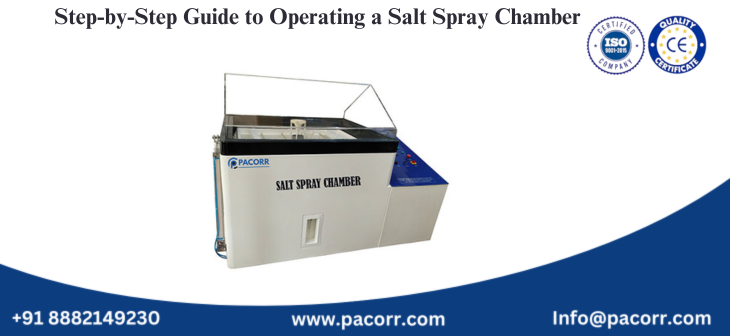
Salt spray testing plays a critical role in evaluating the corrosion resistance of materials and surface coatings. Pacorr’s Salt Spray Chamber is engineered to meet international quality standards, making it a preferred choice for manufacturers aiming to enhance product durability and longevity. This comprehensive guide walks you through the entire process of operating a salt spray chamber effectively, ensuring accurate results and compliance with testing protocols.
Introduction to Salt Spray Chamber Testing
Salt spray (or salt fog) testing is a standardized corrosion test method used to evaluate the corrosion resistance of materials and surface coatings, especially metals. The Salt Spray Chamber from Pacorr creates a controlled corrosive environment to assess how well products can withstand salt-laden conditions over time.
Why use a Salt Spray Chamber?
- To simulate long-term corrosion effects in a short period.
- To assess the durability of protective coatings.
- To evaluate product performance before market release.
Essential Preparations Before Operating the Chamber
Before starting the test, certain preparations are necessary to ensure consistent and reliable test results:
1. Review Testing Standards
- Familiarize yourself with international standards like ASTM B117, ISO 9227, and JIS Z 2371 to align your test procedures with global best practices.
2. Inspect the Equipment
- Check the internal chamber, spray nozzles, salt solution tank, and air pressure system for any blockages, damage, or contamination.
3. Prepare the Test Samples
- Clean the test samples thoroughly and mount them on the sample holders without overlap to ensure uniform exposure.
4. Solution Preparation
- Accurate salt solution preparation is key to reliable results. For a detailed method, refer to Step-by-Step Instructions for Preparing Salt Spray Chamber Solutions.
Operating the Salt Spray Chamber – Step-by-Step Process
Step 1: Power On and Set Parameters
- Switch on the Salt Spray Chamber. Set the test duration, temperature (commonly 35°C for neutral salt spray tests), air pressure, and fog collection rate as per standard requirements.
Step 2: Load the Salt Solution
- Fill the tank with the prepared salt solution (usually 5% NaCl solution). Ensure the solution is free from impurities and properly filtered.
Step 3: Start Air Saturation
- Activate the air saturator to heat and humidify the air before it enters the chamber. This ensures that the air is fully saturated for consistent fogging.
Step 4: Place the Test Samples
- Carefully load the cleaned and mounted samples into the chamber. Ensure proper spacing for uniform exposure to the salt fog.
Step 5: Initiate the Test Cycle
- Close the chamber lid securely and start the test. Monitor the fog density and temperature using the digital display on Pacorr’s Salt Spray Chamber.
Step 6: Test Monitoring and Mid-Test Checks
Although the test is mostly automated, periodically check for:
- Stable chamber temperature
- Uninterrupted fog production
- Nozzle blockages
- Salt solution level
Step 7: Test Completion and Sample Removal
- Once the cycle is complete, turn off the chamber. Open the lid carefully, wearing safety gear. Remove the test samples gently to avoid surface damage.
Post-Test Analysis and Reporting
After the test, the samples are evaluated visually or with measurement tools to assess:
- Rust formation
- Blistering
- Peeling or cracking of coatings
Document all observations along with photographs and compare results with specification standards.
For deeper insight into corrosion testing, read: How to Use a Salt Spray Chamber for Corrosion Testing.
Key Features of Pacorr’s Salt Spray Chamber
- Digital Control Panel: Easy parameter setting and test monitoring.
- Uniform Fog Distribution: Ensures consistent exposure across all samples.
- Compliant with ASTM B117, ISO 9227, JIS Z 2371: Assures globally accepted results.
- Corrosion-Resistant Construction: Prolongs machine life and testing consistency.
Tips to Maximize Test Accuracy
- Use only distilled or deionized water for solution preparation.
- Maintain a clean chamber to avoid contamination.
- Calibrate sensors and controls regularly.
- Follow standard-specific guidelines for sample positioning and test duration.
Conclusion
Operating a salt spray chamber requires precision, adherence to standards, and regular maintenance. Pacorr’s advanced Salt Spray Chamber simplifies the process with user-friendly controls and reliable performance. By following this step-by-step guide, manufacturers can ensure consistent quality checks and boost confidence in product durability across industries.
For more product insights and technical details, visit the Pacorr Salt Spray Tester product page.
Thanks to Pacorr Testing instruments, we have all the required quality testing instruments that have helped us to ensure the best quality delivered to our clients.

Danish
Fair Exports Pvt. Ltd.

